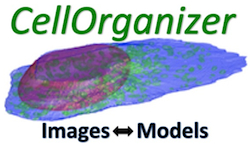CellOrganizer v2.10 Released
The latest release of CellOrganizer (v2.10) contains new and enhanced capabilities.
CellOrganizer (http://cellorganizer.org) contains extensive functionality for converting images of cells and their components into generative models that capture many aspects of cell size, shape and intracellular organization. It contains tools for comparing models from different cell types or conditions in order to provide insight into changes in cell architecture. It can also generate synthetic cell images showing both typical cell organization and its variation within a given cell population. CellOrganizer includes the state-of-the-art method (SPHARM-RPDM) for constructing spherical harmonic-based models of cell, nuclear and organelle shape (https://doi.org/10.1093/bioinformatics/btac688).
This release include an extensive tutorial (https://docs.google.com/document/d/10LFLwMmpuQrN8880Sf0ndh7VYeWZDJ7E/) on using the Docker/Jupyter version of CellOrganizer that does not require a Matlab license. The tutorial consists of 21 Jupyter notebooks covering the major functionalities.
New features include
• functions for directly constructing SPHARM-RPDM representations from individual 3D objects,
• calculation of Jaccard index (in additional to Hausdorff distance) to measure the quality of a given shape representation, and
• ability to generate and customize movies illustrating temporal evolution of shape and organization.


